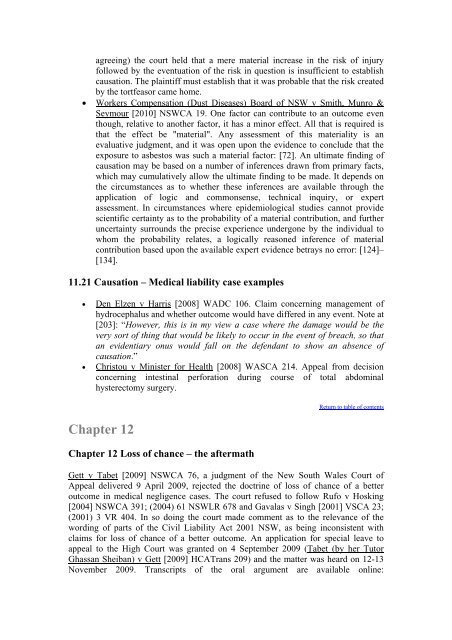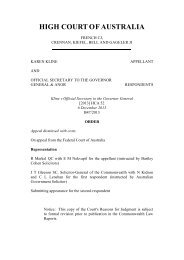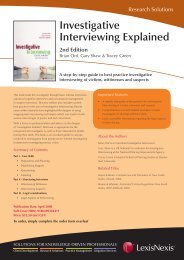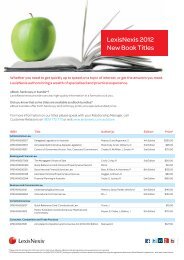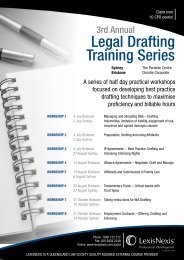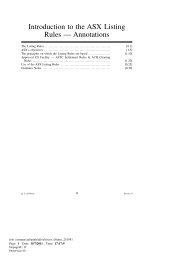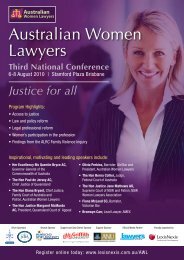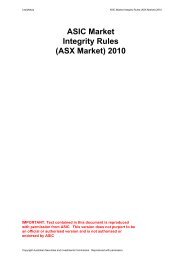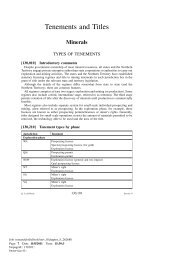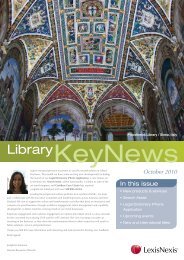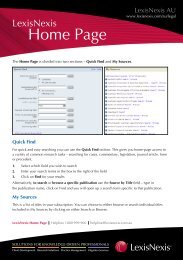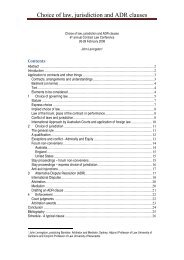Chapter 2 - LexisNexis
Chapter 2 - LexisNexis
Chapter 2 - LexisNexis
You also want an ePaper? Increase the reach of your titles
YUMPU automatically turns print PDFs into web optimized ePapers that Google loves.
agreeing) the court held that a mere material increase in the risk of injuryfollowed by the eventuation of the risk in question is insufficient to establishcausation. The plaintiff must establish that it was probable that the risk createdby the tortfeasor came home.• Workers Compensation (Dust Diseases) Board of NSW v Smith, Munro &Seymour [2010] NSWCA 19. One factor can contribute to an outcome eventhough, relative to another factor, it has a minor effect. All that is required isthat the effect be "material". Any assessment of this materiality is anevaluative judgment, and it was open upon the evidence to conclude that theexposure to asbestos was such a material factor: [72]. An ultimate finding ofcausation may be based on a number of inferences drawn from primary facts,which may cumulatively allow the ultimate finding to be made. It depends onthe circumstances as to whether these inferences are available through theapplication of logic and commonsense, technical inquiry, or expertassessment. In circumstances where epidemiological studies cannot providescientific certainty as to the probability of a material contribution, and furtheruncertainty surrounds the precise experience undergone by the individual towhom the probability relates, a logically reasoned inference of materialcontribution based upon the available expert evidence betrays no error: [124]–[134].11.21 Causation – Medical liability case examples• Den Elzen v Harris [2008] WADC 106. Claim concerning management ofhydrocephalus and whether outcome would have differed in any event. Note at[203]: “However, this is in my view a case where the damage would be thevery sort of thing that would be likely to occur in the event of breach, so thatan evidentiary onus would fall on the defendant to show an absence ofcausation.”• Christou v Minister for Health [2008] WASCA 214. Appeal from decisionconcerning intestinal perforation during course of total abdominalhysterectomy surgery.<strong>Chapter</strong> 12<strong>Chapter</strong> 12 Loss of chance – the aftermathReturn to table of contentsGett v Tabet [2009] NSWCA 76, a judgment of the New South Wales Court ofAppeal delivered 9 April 2009, rejected the doctrine of loss of chance of a betteroutcome in medical negligence cases. The court refused to follow Rufo v Hosking[2004] NSWCA 391; (2004) 61 NSWLR 678 and Gavalas v Singh [2001] VSCA 23;(2001) 3 VR 404. In so doing the court made comment as to the relevance of thewording of parts of the Civil Liability Act 2001 NSW, as being inconsistent withclaims for loss of chance of a better outcome. An application for special leave toappeal to the High Court was granted on 4 September 2009 (Tabet (by her TutorGhassan Sheiban) v Gett [2009] HCATrans 209) and the matter was heard on 12-13November 2009. Transcripts of the oral argument are available online:


